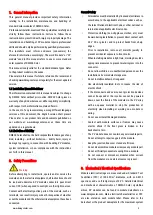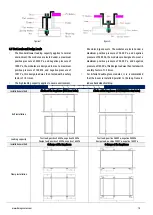
1.
General Information
This general manual provides important safety information
relating to the installation, maintenance and handling of
standard solar modules of DMEGC Solar.
Professional installer must read these guidelines carefully and
strictly follow these instructions. Failure to follow these
instructions may result in death, injury or property damage. The
installation and handling of PV modules require professional
skills and should only be performed by qualified professionals.
The installers must inform end-users (consumers) the
aforesaid information accordingly. The word "module" or "PV
module" used in this manual refers to one or more standard
solar modules of DMEGC Solar.
This manual is only valid for the standard module types. Refer
to the product models in the annex.
Please retain this manual for future reference. We recommend
checking www.dmegcsolar.com regularly for the most updated
version.
1.1 Installation Manual Disclaimer
The information contained in this manual is subject to change
by DMEGC Solar without prior notice. DMEGC Solar gives no
warranty of any kind whatsoever, either explicitly or implicitly,
with respect to the information contained herein.
In the event of any inconsistency among different language
versions of this document, the English version shall prevail.
Please refer to our product lists and documents published on
our website at: www.dmegcsolar.com as these lists are
updated on a regular basis.
1.2 Limitation of Liability
DMEGC Solar shall not be held responsible for damages of any
kind, including
–
without limitation
–
bodily harm, injury or
damage to property, in connection with handling PV modules,
system installation, or non- compliance with the instructions
set forth in this manual.
2.
Safety Precautions
Warning
Before attempting to install, wire, operate and/or service the
module and other electrical equipment, all instructions should
be read and understood. PV module connectors pass direct
current (DC) when exposed to sunlight or other light sources.
Contact with electrically active parts of the module, such as
terminals, can result in injury or death, irrespective of whether
or not the module and the other electrical equipment have been
connected.
General Safety
•
All modules must be installed by licensed electricians in
accordance to the applicable electrical codes such as,
the latest National Electrical Code or other national or
international applicable electrical codes.
•
Protective clothing (non-slip gloves, clothes, etc.) must
be worn during installation to prevent direct contact with
30 V DC or greater, and to protect hands from sharp
edges.
•
Prior to installation, remove all metallic jewelry to
prevent accidental exposure to live circuits.
•
When installing modules in light rain, morning dew, take
appropriate measures to prevent water ingress into the
connector.
•
Do not allow children or unauthorized persons near the
installation site or module storage area.
•
Do not install modules in strong wind.
•
Use electrically insulated tools to reduce the risk of
electric shock.
•
If the disconnects and over current protection devices
cannot be opened or the inverter cannot be powered
down, cover the fronts of the modules in the PV array
with an opaque material to stop the production of
electricity when installing or working on a module or
wiring.
•
Do not use or install damaged modules.
•
Contact with module surfaces or frames may cause
electric shock if the front glass is broken or the
backsheet is torn.
•
The PV module does not contain any serviceable parts.
Do not attempt to repair any part of the module.
•
Keep the junction box cover closed at all times.
•
Do not disassemble a module or remove any module part.
•
Do not artificially concentrate sunlight on a module.
•
Do not connect or disconnect modules when current
from the modules or an external source is present.
3.
Mechanical / Electrical Specifications
Module electrical ratings are measured under Standard Test
Conditions (STC) of 1000 W/m
2
irradiance, with an AM1.5
spectrum, and a cell temperature of 25°C. Detailed electrical
and mechanical characteristics of DMEGC Solar crystalline
silicon PV modules can be found in module datasheets on
www.dmegcsolar.com. Main electrical characteristics at STC
are also stated on each module label. Please refer to the
datasheet or the product nameplate for the maximum system


































